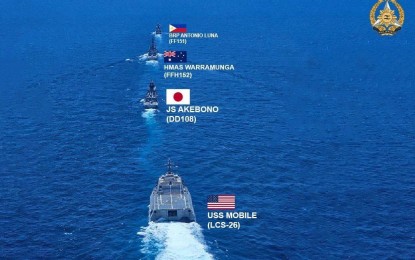
MARITIME COOPERATION. BRP Antonio Luna (top) leads the three other participating ships in a column formation during the division tactics/officer of the watch maneuver exercise during the first multilateral maritime cooperative activity in the West Philippine Sea on Sunday (April 7, 2024). The Armed Forces of the Philippines and the Department of National Defense on Monday (April 8) confirmed that two Chinese People's Liberation Army Navy vessels were detected near the area where the drills were held but did not interfere or issue any radio challenge. (Photo courtesy of Philippine Navy AW109E/NH434)
MANILA – Philippine defense officials on Monday said two Chinese People's Liberation Army Navy (PLAN) vessels were detected from a "distance" during the first multilateral maritime cooperative activity (MMCA) carried out by the Philippines, United States, Australia, and Japan in the West Philippine Sea (WPS).
In an interview with reporters, Armed Forces of the Philippines (AFP) chief Gen. Romeo Brawner Jr., however, said there was no interference from the Chinese vessels during Sunday's MMCA.
"We were able to achieve all the objectives that we have set forth including the anti-submarine warfare exercise that we conducted," he added.
Some of the MMCA exercises included communication exercises, division tactics or officer of the watch maneuvers, and a photo exercise.
Brawner said they are not privy to the purpose of these PLAN ships.
The military chief, meanwhile, said while they were aware of China's conduct of its combat patrols in the South China Sea, he said they did not see such activity in the area where the MMCA was held.
The MMCA's exercise areas were off the coast of Busuanga in Palawan and these participating ships also passed along Sabina Shoal and Reed Bank.
"So we are saying that while we were conducting our own exercises in the WPS, we only monitored the presence of two PLAN ships at wala namang ginawang mga combat patrol or mga exercises (and they were not doing any combat patrols or exercises)," he added.
The Chinese ships were detected off Busuanga and did not issue any radio challenge.
Asked about the distance of the Chinese ships from the vessels participating in the MMCA, the AFP chief said these ships were around six nautical miles away, unlike during the rotation and reprovisioning operations for Ayungin Shoal where the China Coast Guard and its maritime militia partners often tried to forcibly block and even at times ram resupply craft and their escorts.
And when asked what anti-submarine exercise the participating MMCA ships conducted, Brawner said the operation only involved sensing or detecting the possible presence of undersea vessels or submarines.
The AFP chief also emphasized that the MMCA was not a show of force but merely for enhancing the interoperability and enhancing the capabilities of the participating naval forces.
In the just concluded MMCA, the Philippine Navy deployed the offshore patrol vessel BRP Gregorio Del Pilar (PS-15) with its AW-109 helicopter, missile frigate BRP Antonio Luna (FF-151) with its attached AW-159 Wildcat anti-submarine helicopter, and patrol ship BRP Valentin Diaz (PS-177).
Meanwhile, the US Navy participated with its littoral combat ship, USS Mobile, and a P-8A Poseidon aircraft along with the Royal Australian Navy's guided missile frigate HMAS Warramunga and a Royal Australian Air Force P-8A Poseidon maritime patrol aircraft; and Japan Maritime Self-Defense Force's destroyer JS Akebono.
Meanwhile, Department of National Defense (DND) spokesperson Arsenio Andolong confirmed Brawner's statement about the presence of two PLAN vessels but "they kept a distance and they did not impede or interfere with the activity yesterday."
The DND spokesperson said the Chinese vessels have bow numbers 792 and 162.
Andolong, meanwhile, said the possibility of holding this type of drill in the future will depend on the "strategic objective" of the countries interested in participating.
Bolstering PH defense
Meanwhile, AFP spokesperson Col. Francel Margareth Padilla said the successful MMCA signifies a "significant enhancement in our defensive capabilities."
"The meticulously planned activities, including communication exercises, division tactics, and officer of the watch maneuvers, have effectively strengthened our forces' ability to work together in diverse maritime scenarios," she added.
Padilla also said this underscores the Philippines' commitment to bolstering its national defense and security posture.
"We are confident that through continued cooperation and training initiatives, we will further enhance our readiness to address any potential threats to our maritime domain and uphold peace and stability in the region in tandem with like-minded nations," she added. (PNA)
